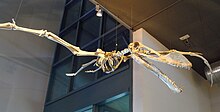This is an old revision of this page, as edited by Abyssal (talk | contribs) at 15:24, 4 September 2015 (removed Category:Early Cretaceous pterosaurs; added Category:Early Cretaceous pterosaurs of South America using HotCat). The present address (URL) is a permanent link to this revision, which may differ significantly from the current revision.
Revision as of 15:24, 4 September 2015 by Abyssal (talk | contribs) (removed Category:Early Cretaceous pterosaurs; added Category:Early Cretaceous pterosaurs of South America using HotCat)(diff) ← Previous revision | Latest revision (diff) | Newer revision → (diff)
| Coloborhynchus spielbergi Temporal range: Early Cretaceous, 108 Ma PreꞒ Ꞓ O S D C P T J K Pg N ↓ | |
|---|---|

| |
| Skeletal cast of the possible species C. spielbergi | |
| Scientific classification | |
| Domain: | Eukaryota |
| Kingdom: | Animalia |
| Phylum: | Chordata |
| Order: | †Pterosauria |
| Suborder: | †Pterodactyloidea |
| Genus: | †Coloborhynchus |
| Species: | †C. spielbergi |
| Binomial name | |
| †Coloborhynchus spielbergi Veldmeijer, 2003 | |
| Synonyms | |
|
Anhanguera spielbergi | |
Coloborhynchus spielbergi is a pterosaur species from the Aptian-age Romualdo Member of the Lower Cretaceous Santana Formation, of Barra do Jardim, Araripe Plateau, Ceará Province, Brazil. C. spielbergi was named after the filmmaker Steven Spielberg.
Description
C. spielbergi was a large species originally based on RGM 401 880, a fossil specimen known from a nearly complete skull and parts of the skeleton currently housed in the Nationaal Natuurhistorisch Museum in the Netherlands.
Like other species assigned to the genus Coloborhynchus, C. spielbergi bore large, rounded crests at the ends of expanded upper and lower jaws. However, rather than being robust and box-shaped as in many Coloborhynchus species, the jaw tips were more slender and spoon-shaped, and the crest is thin from top to bottom, both features commonly seen in species typically referred to Anhanguera, a genus in which C. speilbergi is classified by some researchers (as A. spielbergi). As in other ornithocheirids, the size and orientation of the teeth vary considerably along the jawline. In C. spielbergi, the tooth pattern has been described as more similar to that of Tropeognathus robustus than to Anhanguera piscator.
Classification
This species was originally classified in the genus Coloborhynchus due to the flattened upper jaw behind the crest, and a raised maxilla, though the usefulness of those in ornithocheirid classification has been questioned. Because the front half of the skull was poorly preserved, characteristics found there may not be ideal for comparing with similar species to determine genus assignment. Additionally, a flattened snout has been reported to be widespread among similar species, including those referred to Anhanguera.
References
- Veldmeijer, A.J., H.J.M. Meijer, and M. Signore (2006). "Coloborhynchus from the Lower Cretaceous Santana Formation, Brazil (Pterosauria, Pterodactyloidea, Anhangueridae); an update." PalArch’s Journal of Vertebrate Palaeontology, 3(2): 15-29.
- Rodrigues, T. and Kellner, A.W.A. (2008). "Review of the pterodactyloid pterosaur Colobrohynchus." Pp. 219–228 in: Hone, D.W.E. and Buffetaut, E. (eds), Flugsaurier: pterosaur papers in honour of Peter Wellnhofer. Zitteliana B, 28.